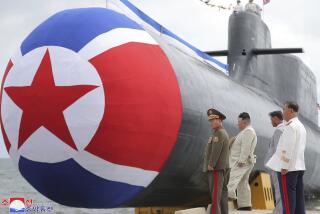Soviet Nuclear Sub Sinks Off Norway; Casualties Feared
- Share via
WASHINGTON — An advanced Soviet attack submarine caught fire and sank in the Norwegian Sea Friday, according to U.S. and Norwegian government sources.
The nuclear-powered “Mike”-class submarine suffered a catastrophic accident involving “major loss of life,” according to a U.S. government official who asked not to be identified.
U.S. officials said they did not know what weapons the craft was carrying, but the sub is capable of launching SSN-21 cruise missiles with either nuclear or conventional warheads.
An American official monitoring reports on the incident said the vessel surfaced briefly, then sank.
Intelligence Bonanza
The accident involving the submarine, believed to be the only one of its kind, may provide an intelligence bonanza for the United States and its allies if reconnaissance ships, aircraft or satellites were able to photograph the rare craft as it surfaced.
In Oslo, the Norwegian Defense Ministry said that Soviet ships and aircraft were in the area where the sub was lost in international waters off Spitzbergen Island near the Arctic Circle.
The statement said Norwegian military aircraft had flown over the area, about 300 miles from the Norwegian mainland, and had seen the submarine ablaze. Officials said the fire appeared to be concentrated in the stern of the vessel, where water distillation equipment and propulsion functions are housed.
In an interview broadcast on Britain’s Independent Television News, Norwegian Defense Ministry spokesman Col. Gullow Gjeseth said that in a flight over the submarine, “I saw at the time two dinghies with the personnel in one dinghy. We saw also a Soviet merchant ship in the area, and we know also Soviet aircraft have been over the area.”
Only One of Type
The Soviets have built only one submarine of this type, according to the authoritative Jane’s Fighting Ships.
Built as Platform
U.S. naval intelligence analysts said it was built as a platform for experiments in submarine design, and may have special coatings and a unique propulsion system. The sub’s design reduced both the turbulence and noise that the boat creates when it is moving, making it harder to locate in the cat-and-mouse game that U.S. and Soviet submarines play undersea.
The 361-foot-long vessel, believed to carry a crew of about 95, was launched at Severodvinsk in May, 1983. It is powered by twin, liquid-metal-cooled nuclear reactors and has an estimated top speed of 38 knots.
The double-hulled ship is probably made of titanium for weight and noise reduction, according to Jane’s. Norman Polmar, an independent American naval analyst, said the stricken submarine could have been carrying as many as six nuclear-tipped torpedoes.
White House Press Secretary Marlin Fitzwater said U.S. officials had little information on the incident Friday night.
Expresses Sympathy
“There are indications there was a major fire aboard, but we have no details. We understand there has been a loss of life but we can’t confirm how many,” Fitzwater said. “We express the sympathy of the United States government to the Soviet government for any loss of life involved.” President Bush had been notified of the accident, Fitzwater said.
The area where the accident took place in the Norwegian Sea is the site of many naval exercises by both Eastern and Western forces and is considered a potential battleground in a future large-scale future conflict. Western forces practice keeping Soviet submarines away from Atlantic shipping lanes, while Soviet vessels patrol there to keep track of Western ships.
With the vessel burning and disabled on the surface, Western intelligence analysts hoped to get their first look at some of the sub’s secrets.
One analyst said that before sinking, the submarine could have unleashed its ballast, causing the boat to pop up high on the surface of the ocean and exposing some of the sub’s underside.
“This really could be an intelligence coup,” said one American naval analyst. When a disabled Soviet Victor-class submarine surfaced off Newport, R.I., in the mid-1980s, analysts reaped a harvest of valuable intelligence about the sub.
Could Be Hazardous
But the accident poses potentially severe environmental hazards as well. Previous submarine accidents have resulted in release of radiation, and in 1961 members of a Soviet submarine crew died of radiation poisoning after an accident in the Baltic, according to recently declassified CIA documents.
It was not clear whether this accident also posed the danger of significant environmental damage.
The latest incident would be the fourth sinking of a Soviet nuclear-powered submarine.
A Soviet Yankee-class ballistic missile sub sank 600 miles east of Bermuda in 1986. A Charlie-class cruise-missile submarine sank off Kamchatka Peninsula in 1983. And in 1970, the November-class torpedo-attack submarine sank off the Atlantic coast of Spain.
Two U.S. nuclear submarines have been lost at sea--the Thresher off the U.S. East Coast in 1963, and the Scorpion off the Azores Islands in 1968.
More to Read
Sign up for Essential California
The most important California stories and recommendations in your inbox every morning.
You may occasionally receive promotional content from the Los Angeles Times.














